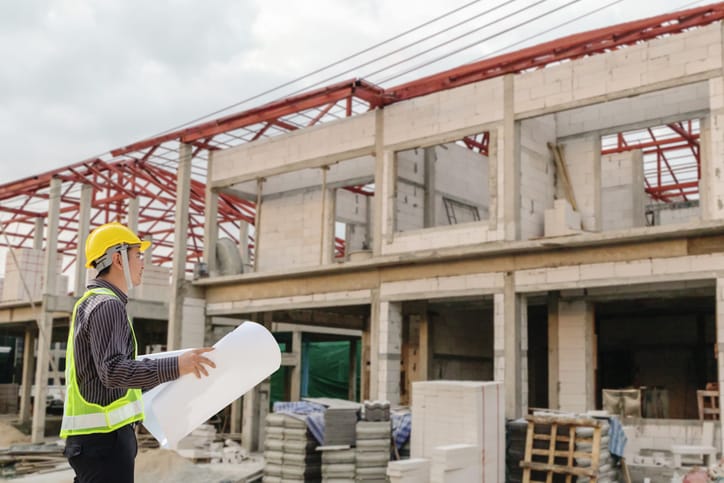
Global supply chains are the backbone of the construction industry, ensuring seamless access to materials, equipment, and labor. As noted by The ProLift Rigging Company, their intricate nature brings both opportunities and challenges. With the industry heavily reliant on global trade to meet project demands, any disruption in these networks can lead to delays, cost overruns, and compromises in quality.
Additionally, there is a growing emphasis on sustainability and regional sourcing to mitigate risks tied to international logistics. As the construction sector evolves, strengthening supply chains has become paramount for tackling disruptions and aligning with future demands. A balance between technology adoption, diversification, and sustainability will define how the industry adapts to a changing global landscape.
Role of Global Supply Chains in Construction
Global supply chains are vital to the construction industry, ensuring the availability of essential materials, equipment, and labor across projects of all sizes. Whether it’s sourcing steel from overseas manufacturers or acquiring specialized machinery, these networks play a pivotal role in keeping construction activities running smoothly.
The construction sector heavily relies on global trade to meet demand, particularly for raw materials that may not be locally available. Projects often depend on timely deliveries from international suppliers, highlighting how interconnected the industry has become. Delays or disruptions in these supply chains can have ripple effects, impacting timelines and budgets.
Key Components and Challenges of Construction Supply Chains
The construction supply chain is a complex web involving the procurement of materials like steel, timber, and concrete, as well as the acquisition of advanced machinery and specialized tools. These components are crucial to meeting the diverse demands of modern construction projects, from residential housing to large-scale infrastructure.
However, this reliance on global networks also exposes the industry to significant challenges. Trade restrictions, geopolitical uncertainties, and fluctuating material costs present ongoing hurdles. Labor shortages only compound these issues, particularly in regions where skilled workers are in short supply. Recent disruptions, such as those caused by the pandemic, have highlighted vulnerabilities in logistics and transportation, forcing companies to rethink their sourcing strategies.
Impact of Supply Chain Disruptions on Construction
When supply chains falter, the consequences can be severe for construction projects. Delays in material deliveries often lead to postponed deadlines, which can snowball into financial strain for contractors and developers. Material shortages have a direct impact on construction quality, as companies may be forced to opt for alternative resources that don’t meet the same standards.
This trickle-down effect also places stress on downstream industries, particularly in housing, where delays can exacerbate affordability issues or stall critical infrastructure developments that communities rely on. The cascading nature of these disruptions underscores the fragility of current supply chain systems. Additionally, the unpredictability of such disruptions necessitates proactive planning and robust contingency measures to mitigate risks.
Solutions for Strengthening Supply Chains
Adopting advanced technology has become a cornerstone of improving supply chain resilience in construction. Tools such as AI-driven logistics platforms and IoT-enabled tracking systems allow companies to monitor shipments in real-time, identify bottlenecks, and optimize delivery routes. These innovations empower firms to respond more effectively to unforeseen disruptions and maintain project momentum.
Efforts to diversify suppliers and source materials locally are also gaining traction. By reducing dependence on a single region or vendor, construction companies can create more flexible procurement plans. Additionally, long-term partnerships with suppliers promote trust and stability, ensuring that critical resources remain accessible even during periods of global uncertainty. Sustainability initiatives, like using recycled materials, are further shaping how firms approach supply chain improvements. Localized manufacturing and circular economy principles are also becoming integral to achieving supply chain efficiency and resilience.
Innovations Driving Supply Chain Evolution
Digital transformation is reshaping how supply chains operate in construction. Blockchain technology is emerging as a game-changer by enhancing transparency and traceability throughout the procurement process. This increased visibility ensures accountability and reduces the risk of fraud or disputes between stakeholders. Similarly, predictive analytics is helping firms anticipate demand fluctuations, enabling better planning and reducing material waste.
The push toward regionalization is another trend redefining supply chains. By focusing on sourcing materials closer to project sites, companies can mitigate risks tied to international shipping delays. This shift not only accelerates delivery times but also aligns with global efforts to reduce carbon emissions. Automation in warehousing and logistics is streamlining operations, cutting costs, and improving overall efficiency in meeting the dynamic needs of the construction sector. Innovations like 3D printing and advanced robotics are also starting to contribute to enhanced supply chain processes, offering exciting possibilities for the future.
Outlook for Global Supply Chains
The future of global supply chains in construction is poised to center around resilience, adaptability, and sustainability. Companies are investing in technologies that enhance supply chain visibility, enabling them to predict and respond to disruptions with greater agility. These tools will likely become standard as firms prioritize long-term stability over short-term cost savings.
Sustainability will continue to play an important role in shaping the industry. The growing emphasis on green construction practices, such as using eco-friendly materials and reducing waste, will influence how supply chains operate. Moreover, as global trade policies evolve and regional supply networks strengthen, we may see a gradual reduction in reliance on distant suppliers. With greater collaboration across stakeholders and a focus on innovation, the global construction industry is well-positioned to overcome challenges and thrive in the years ahead.


